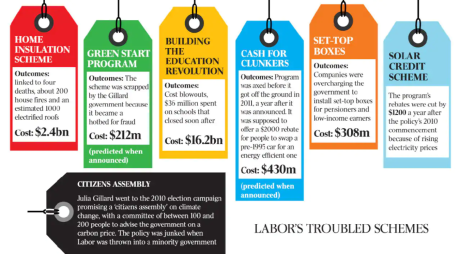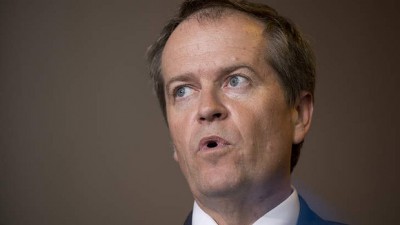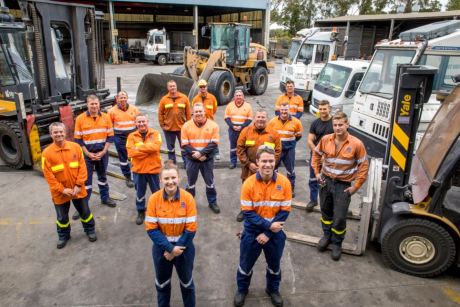Labor Lunacy: Industry Wipeout Looms as Bill Shorten Doubles-down on Wind & Solar Insanity
November 24, 2018 by 1 Comment
Labor – aka the ‘Workers Party’ – is determined to destroy whole industries and thousands of jobs with a 50% RET and a giant ‘carbon’ tax.
Australian industry has been a protected species since the Victorian gold rush in the 1850s, cosseted behind an insurmountable wall of tariffs and propped up with subsidies. As the tariffs and subsidies to industries – such as motor manufacturing, clothing and footwear – were slashed in the 1990s, hundreds of businesses and entire industries have disappeared.
Nowadays, mining, manufacturing and mineral processing is being treated by politicians as a class of mangy vermin – fit only for urgent eradication – with a raft of utterly insane energy policies which threaten thousands of small and large businesses, alike.
Thanks to Australia’s obsession with heavily subsidised and chaotically intermittent wind and solar, mining, mineral processing, manufacturing and agriculture already face the nightmare scenario of rocketing power prices and an unreliable, and unpredictable supply. Precisely the disastrous combination that destroyed South Australia’s manufacturing industry and which is all set to destroy what’s left of its mineral processing businesses, too. Nyrstar’s lead and zinc smelter at Port Pirie is on life support, unlikely to survive.
The current state of affairs is bad enough. However, opposition leader and Trade Union puppet, Bill Shorten is about to double-down with an energy policy that’s guaranteed to destroy hundreds of thousands of meaningful jobs. Although, to call it a ‘policy’ is to flatter it, as if it involved some form of deliberate consideration and design. Here’s a snapshot of an economic disaster in the making.
Labor faces industry backlash as big energy user criticises policy
The Australian
Joe Kelly
23 November 2018
The nation’s largest single electricity user has questioned how it will keep power running at its Tomago aluminium smelter under Labor’s 45 per cent emissions reduction target and $10 billion plan to turbo-charge investment in renewables, declaring that “batteries are not a solution”.
The warning from Tomago Aluminium chief executive Matt Howell came as Scott Morrison attacked Bill Shorten’s scheme to install one million new household battery storage systems across the country by 2025, saying it would lead to a repeat of the mistakes of the Rudd government’s botched home-insulation program.
“This is a throwback; a throwback to the Rudd-Gillard-Rudd failures of their time in government,” the Prime Minister said yesterday. “What we have got here is we have gone from pink batts to pink batteries. They never learn from their mistakes.”
Government analysis also suggested that Labor’s plan to provide $2000 subsidies for up to 100,000 household battery installations could burden average families with loan repayments of more than $300 each month over a period of several years.
The rebates are available for households with an income of less than $180,000, with the cost of batteries starting at about $10,000.
In a move that would phase out the nation’s reliance on coal-fired power, the Opposition Leader announced that Labor would inject $15bn into new renewable energy projects and an upgrade of Australia’s transmission and distribution systems, as well as reviving Malcolm Turnbull’s national energy guarantee.

Mr Shorten’s energy package included a $10bn capital injection for the Clean Energy Finance Corporation to boost investment in large-scale clean energy projects as well as the creation of a $5bn Energy Security and Modernisation Fund.
Mr Howell demanded more detail on Labor’s policy, noting that the smelter in the Hunter region consumed a steady load of 960 megawatts and accounted for about 11 per cent of NSW’s average power demand.
Energy Minister Angus Taylor warned yesterday that hundreds of thousands of jobs dependent on the supply of affordable and reliable power could be jeopardised by the Labor plan, including the 1100 jobs at Tomago.
“We are layering in intermittency, with more and more wind and solar coming in, displacing coal,” Mr Howell told The Australian.
“What I think about it (the Labor policy) is, there is insufficient detail. How will we achieve the 45 per cent emissions reduction across the country and 50 per cent renewable target and keep the lights on for energy intensive manufacturing? If Australia wants to be a nation that makes things — bricks, glass, cement, steel and aluminium in particular — you’ve got to have internationally affordable and reliable energy. We are deeply, deeply concerned that our smelter is being called upon to load-shed when there is insufficient reserve margin in the National Electricity Market.”
Mr Howell noted that the Hornsdale Power Reserve — a battery storage facility in South Australia — would only be able to power the Tomago smelter for less than eight minutes. “Clearly batteries are not a solution,” he said.
Manufacturers also demanded more detail on what impact Labor’s more ambitious target to reduce carbon pollution by 45 per cent on 2005 levels by 2030 would have on emissions-intensive, tradeexposed industries.
Business and industry groups seized on Labor’s announcement to pressure the major parties into reviving the former prime minister’s national energy guarantee, warning that alternative plans to underwrite new power generation were fraught with risk.
Manufacturing Australia chief executive Ben Eade welcomed the “inclusion of the NEG framework” in Labor’s policy, but questioned how the more ambitious emissions-reduction target would affect industry. “We hope to see more detail about how extending one element — in this case emissionsreduction targets — would impact energy reliability and price, and in particular the impact on emissions-intensive, trade-exposed industries,” he said.
Mr Taylor said last night that Labor was asking families “struggling with their energy bill to shell out an extra $10,000 to $22,000 to pay for their pink batteries scheme”. “It does nothing more than saddle families with hundreds of dollars of monthly debt while locking them into today’s battery technology for the life of their loan term,” the minister said.
He said that if Labor was going to reduce emissions by 45 per cent, it would need an “explicit or hidden carbon price”, which could include vehicle-emissions limits as well as limits on stocking rates for farmers. “There are many ways to do it. You can call it what you like, but it’s a carbon tax,” he said.
Mr Taylor argued that, if the $10bn capital injection for the CEFC led to more intermittent power pushing out reliable generation from the energy mix, “then we can say goodbye to much of our manufacturing industry”.
“Aluminium will go early. And there’s no doubt this poses a threat to cement manufacturing, to fertiliser, to steel. But it also poses a threat to less-obvious industries like agriculture that relies on refrigeration,” Mr Taylor said.
Labor’s environment spokesman Mark Butler said the party would release more policy information in coming weeks, and was consulting companies such as Woodside about “a sort of emissions trading scheme”. Labor’s energy infrastructure fund would funnel investment into the upgrading of interconnectors as well as the building of new ones, such as a second connection across Bass Strait.
The Labor shake-up would also transition workers out of ageing coal plants, provide grants of up to $20,000 for manufacturers who wanted to improve energy efficiency, and establish a system of new “community power networks” across the country.
Mr Shorten said his plan was “about outlining our vision for the future”. “It is 50 per cent renewable energy by 2030; it is cutting pollution by 45 per cent by 2030; cutting power bills by hundreds of dollars a year; and creating tens of thousands of new renewable-energy jobs,” he said.
Business Council of Australia chief executive Jennifer Westacott said the NEG was a “credible, workable, market-based solution” to address the issues of affordability, reliability and carbon pollution.
The Australian
Angus Taylor can add agricultural and horticultural businesses that rely upon irrigation to his list of businesses under threat from rocketing power prices.
In South Australia’s Riverland, irrigators have uncoupled from the grid to run their own diesel generators and diesel-powered pumps. Fruit and juice packers, including wineries, have backup diesel generators to keep their refrigerators running 24 x 7, to avoid stock losses whenever they’re hit with another bout of South Australia’s notorious load shedding.
As STT followers are aware, South Australia – Australia’s wind and solar capital – suffers the world’s highest retail power prices. Hardly a recipe for investment in anything, let alone energy intensive agriculture, horticulture or aquaculture, mineral processing or manufacturing.
Manufacturing Australia chief executive Ben Eade and Jennifer Westacott are seriously mistaken if they really think that the NEG will be resuscitated. Like all mandated subsidy scams for wind and solar, it needs wholesale bipartisan support, which it will never have.
The NEG was killed by the same rebel Liberal and National MPs who made Malcolm Turnbull walk the plank, when he tried to crank up the emissions component of that ill-fated policy.
The inclusion of an enormous emissions target within the NEG (as well as what would have been a 42% RET) means that the notionally conservative side of politics will never support it. Which brings us to Mark Butler – a man who would have been right at home with Leon Trotsky, as he helped Lenin whip the proletariat into a frenzy in October 1917.
By headlining the fact that Labor is (once again) determined to introduce a great big ‘carbon’ tax, Butler has provided the greatest political gift that the Liberal/National Coalition could have hoped for. It was Labor’s Julia Gillard and her great big carbon tax that handed Tony Abbott the keys to the Lodge and a whopping majority in the House, back in 2013. For all the talk about Australian voters spreading themselves senseless about CO2 gas, they voted in droves against a policy that would have cost them very dearly, indeed. Something about notional virtue not being worth the ticket price, we think.
Energy Minister, Angus Taylor and his PM, Scott Morrison need only start smashing Bill Shorten over his great big ‘carbon’ tax to give the Liberal/National coalition a fighting chance at the next election (to be held in either March or May next year).
As an aside, we take it that when Jennifer Westacott refers to ‘carbon’ she means carbon dioxide gas, which only the climate cult and hopeful profiteers count as “pollution”. CO2 is, of course, a thoroughly beneficial, naturally occurring trace gas, essential for all life on earth; 97% of the CO2 that roams the atmosphere is the product of entirely natural sources. [Note to Ed: if it spews out of a swamp or volcano or me or my faithful hound, is that pollution, too?].
Westacott heads the Business Council of Australia. Among its members, there are dozens of major operators in the financial sector, salivating at the opportunity of making a fortune from trading carbon credits and/or clipping the ticket, along the way.
There’s something deeply unsettling when a business lobby and trade unions all start supporting a policy which spells the inevitable destruction of hundreds of thousands of jobs, and an end to Australia’s dream run of growth and prosperity.
Trade union support is pretty easy to explain: their leaders and Labor mates head up enormous slush funds (referred to as industry superannuation funds). Industry super funds have invested heavily in the renewables rort, not least through IFM Investors (run by Labor heavyweights, Greg Combet and Garry Weaven) and Pacific Hydro.
Trade union support then, is really a case of asking for a whole lot more the same. However, short-term profiteering will come with an enormous cost. Ultimately, their membership will evaporate, as whole industries simply disappear. That’s precisely what happened with the motor manufacturing industry in this country, driven out by rising energy and labour costs, with the latter pushed to uncompetitive levels by unrelenting pressure from unions. A classic case of killing the goose that laid the golden egg.
Where, traditionally, Labor men were practical characters, drawn from rail-yards and shearing sheds who put pragmatism first, the new breed (like Butler) are driven by ideology and treat their hard-wired, selfish cynicism as a virtue.
Labor has now given Australian voters a very good reason to stick with the Liberal/National Coalition.
Policy brownout under Labor’s energy scheme
The Australian
22 November 2018
Energy is a vital issue for next year’s election because households and business are acutely aware that policy failure has damaged the competitive advantage Australia once enjoyed in affordable, reliable power. South Australia blew up its last coal-fired power station last year, pursued the renewables mirage, and ended up paying dearly for dirty diesel generators and battery storage.
The former Weatherill government presided over some of the highest power prices in the world. Its Labor comrades in Victoria tripled the brown coal royalty rate and brought forward the closure of the Hazelwood coal-fired generator last year; wholesale power prices rose by 80 per cent. The loss of baseload supply has been funded by taxpayers as federal governments both Labor and Coalition have fed subsidies to intermittent power sources. So far, energy policy has been a no-go area for the Morrison government; its role in the leadership implosion is fresh in memory.
Against this background, the minimum requirement for Bill Shorten’s energy policy is to learn from past errors and not make things worse. Unfortunately, hubris is a renewable resource. As with its old SA colleagues, federal Labor preens itself as a bold administration with a 50 per cent renewable energy target (the share was just 15 per cent last year) and a goal to cut emissions 45 per cent by 2030 (Australia accounts for only 1.3 per cent of global greenhouse gases).
Labor says it also will deliver affordability and reliability of supply, plus certainty for investment. It declares blithely that coal has no future, indifferent to the 2022 scheduled closure of NSW’s Liddell coal-fired power station. Four other baseload sources (three coal-fired, one gas) in four states are also threatened with closure, according to the Minerals Council of Australia.
Opposition climate change and energy spokesman Mark Butler says Labor would encourage new gas-fired power, which is fair enough. In addition, he says, a Labor government would underwrite new renewable power sources and storage while assisting upgrades to transmission and distribution. The idea is that competitive auctions will drive down the price of supply, with government contracts giving investors the necessary confidence.
The headline figure is a $10 billion capital injection for the Clean Energy Finance Corporation yet Mr Butler claims this would not involve picking winners or a government subsidy, since he asserts that the cost of renewable energy, available on demand, is already lower than that of fossil fuel-driven power. It’s a contradiction. There’s no escaping the fact $10bn in taxpayer funds will be put at risk to some degree because, by its own admission, Labor will be supporting ventures that “cannot be left up to the big power companies”, meaning the business case may be weak. Apart from underwriting projects, a Shorten government would also use concessional loans and equity stakes; that’s more exposure. And it would pick winners in the sense of favouring renewables, even if clean coal might be favoured by a dispassionate cost-benefit analysis. It’s simply not clear how Labor would compensate for the loss of coal-fired baseload power.
Voters should find it easier to grasp the pros and cons of Labor’s $2000 subsidies for 100,000 households to install battery storage for better use of solar panels. A giveaway has immediate appeal but scepticism kicks in pretty quickly for most Australians.
The Rudd government’s pump-prime schemes of roof insulation and school halls have not been forgotten. A pot of public money led to price-gouging, poor safety (four insulation installers died) and over-engineering (in school structures) or shoddy work because the spike in demand attracted dodgy tradies. Labor’s battery subsidies would have a trivial effect on the operation of the grid but they would be unlikely value for money.
The price of batteries would rise with demand, so consumers may remain unconvinced of the payback proposition of investing in these systems. Households with disposable income may well buy enough battery storage to go off the grid, worsening the inequity already represented by solar panels with feed-in tariffs. People less well-off have to cough up more money to pay for the necessary upgrades and maintenance of infrastructure. Although Labor’s battery grant is means tested, households still would have to find about $10,000. Mr Shorten also expects people to go into debt (with “low-cost loans”) for Labor to reach its battery targets.
For all these reasons, the government has an opportunity to make Labor pay a heavy political price on energy policy. It’s a question of sharpening the choice between ideology-free lower prices and reliable power on the one hand, and the chaotic expense of a renewables fetish on the other. Although Labor intimates it has jettisoned a carbon price, Mr Butler conceded there would be “emissions trading-type schemes” in manufacturing and other sectors. Voters may ask if Labor may revisit a Julia Gillard-style carbon tax that supposedly was never going to be imposed.
The Australian



No comments:
Post a Comment